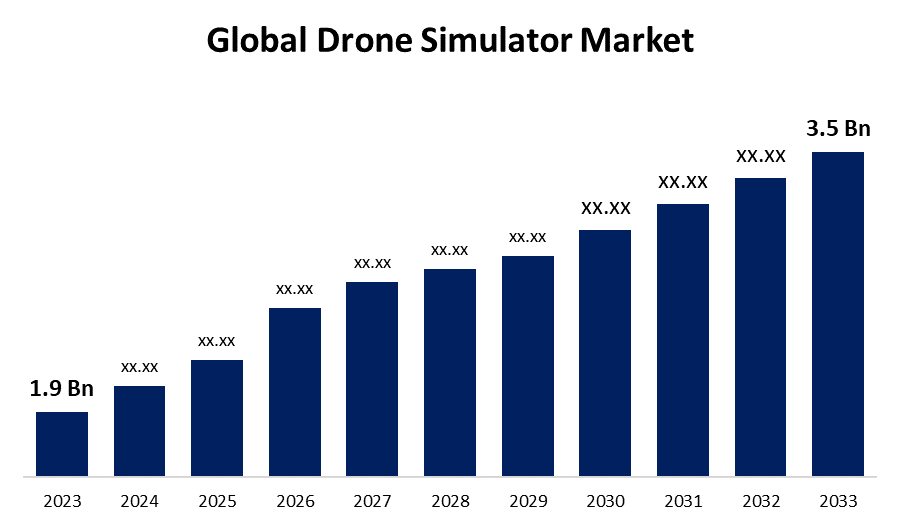Global Drone Simulator Market Size To worth USD 3.5 billion by 2033 | CAGR of 6.30%
Category: Aerospace & DefenseGlobal Drone Simulator Market Size To worth $3.5 billion by 2033
According to a research report published by Spherical Insights and Consulting, the Global Drone Simulator Market Size to grow from USD 1.9 billion in 2023 to USD 3.5 billion by 2033, at a Compound Annual Growth Rate (CAGR) of 6.30% during the forecast period.

Get more details on this report -
Browse key industry insights spread across 235 pages with 116 Market data tables and figures & charts from the report on the "Global Drone Simulator Market Size, Share, and COVID-19 Impact Analysis, By Component (Hardware, Software); By System (Fixed, Portable); By Application (Commercial, Military); By Drone (Fixed Wing, Rotary Wing), and By Region (North America, Europe, Asia-Pacific, Latin America, Middle East, and Africa), Analysis and Forecast 2023 - 2033" Get Detailed Report Description Here: https://www.sphericalinsights.com/reports/drone-simulator-market
The drone simulator market has seen significant growth due to the increasing use of drones across industries such as agriculture, defense, filmmaking, and logistics. These simulators offer a cost-effective and risk-free training solution, helping drone operators improve their skills in a controlled environment. As technology advances, modern simulators now feature realistic flight dynamics, 3D environments, and real-time feedback. The demand for these tools is further fueled by the growing need for safe, efficient drone training in response to heightened concerns about drone safety and regulatory compliance. Moreover, the integration of artificial intelligence and machine learning enhances the training experience. As drone applications continue to expand globally across various sectors, the market for drone simulators is expected to keep growing.
Drone Simulator Market Value Chain Analysis
The value chain of the drone simulator market includes several critical stages, such as raw material sourcing, software development, integration, and end-user applications. The process starts with hardware manufacturers who produce the essential components, including controllers, sensors, and computers, needed for the simulators. Software developers create the simulation environments, flight models, and user interfaces, incorporating real-time data and realistic scenarios. Integration companies then assemble the full simulator systems, ensuring seamless compatibility between hardware and software. The next phase involves distribution, where companies promote and deliver simulators to users in sectors like defense, education, and commercial enterprises. Lastly, training providers and organizations use these simulators for educational purposes, while support services, such as software updates and maintenance, ensure the continued growth of the market.
Drone Simulator Market Opportunity Analysis
The drone simulator market offers substantial growth potential, driven by multiple factors. As drones become increasingly prevalent in industries like agriculture, real estate, filmmaking, and emergency services, the demand for skilled drone operators rises, creating a need for affordable, scalable training solutions. The growth of the commercial drone sector and stricter regulatory standards further highlight the importance of effective training, boosting the need for simulators. Technological innovations, such as the integration of AI and machine learning, provide opportunities to enhance realism and improve training efficiency, attracting more users. Additionally, as drone technology advances, the demand for simulators to support new features and flight models opens avenues for product innovation. Expanding into emerging markets and offering tailored solutions also presents significant growth opportunities worldwide.
Increasing investments in artificial intelligence (AI) are playing a pivotal role in driving the growth of the drone simulator market. AI technologies enable the development of more advanced, realistic simulation environments, enhancing training precision and improving the overall user experience. By integrating AI, drone simulators can tailor training to individual learning speeds, offer real-time feedback, and simulate complex flight scenarios, making the training process more effective and efficient. Additionally, AI integration refines flight models and improves the accuracy of drone behavior, providing a deeper understanding of drone operations in various conditions. As AI technology evolves, drone simulators will feature even more advanced capabilities, attracting a broader range of industries, including both commercial and defense sectors. This surge in AI investment is expected to drive innovation and create new growth opportunities in the drone simulator market.
One of the main challenges is the high cost of advanced simulators, which may discourage small businesses and individual users from adopting this technology. Additionally, developing highly realistic simulation environments that accurately mimic real-world conditions presents a technical hurdle, requiring ongoing innovation in both software and hardware. The rapid evolution of drone technology also makes it challenging for simulators to stay up-to-date, risking obsolescence unless regularly updated. Another issue is the lack of standardization within the industry, which can lead to compatibility problems between different simulator systems and actual drones. Finally, the shortage of skilled professionals who can effectively design and operate these advanced simulators may slow market growth in certain regions.
Insights by Component
The software segment accounted for the largest market share over the forecast period 2023 to 2033. As drone usage continues to grow across sectors like agriculture, defense, and logistics, the demand for advanced software that accurately simulates real-world flight conditions has increased. Modern simulators now incorporate artificial intelligence, machine learning, and 3D modeling to create highly immersive environments, delivering personalized training experiences and real-time feedback. Furthermore, the rising focus on regulatory compliance and safety standards is driving the adoption of software-based training solutions. Software developers are constantly innovating to enhance flight dynamics, improve user interfaces, and ensure compatibility across various drone models. With these technological advancements, the software segment is expected to see steady growth, playing a key role in the overall expansion of the drone simulator market.
Insights by Drone
The fixed wing segment accounted for the largest market share over the forecast period 2023 to 2033. The growth of the fixed-wing drone simulator segment is driven by the increasing adoption of fixed-wing drones in industries such as agriculture, defense, surveying, and environmental monitoring. Fixed-wing drones offer benefits like longer flight durations, higher payload capacity, and larger coverage areas, making them well-suited for these sectors. As demand for fixed-wing drones rises, there is a growing need for specialized training solutions, which has led to a surge in the use of fixed-wing simulators. These simulators provide realistic flight dynamics, enabling operators to master the complexities of controlling fixed-wing drones in diverse conditions. The segment is further bolstered by advancements in simulation software, ensuring higher accuracy and immersion. As the fixed-wing drone market continues to expand, this segment is expected to grow, playing a significant role in the overall development of the drone simulator market.
Insights by System
The portable segment accounted for the largest market share over the forecast period 2023 to 2033. Portable simulators provide convenience by allowing drone operators to train anywhere, eliminating the need for a fixed location or bulky equipment. This flexibility is particularly beneficial for industries with mobile or remote operations, such as agriculture, surveying, and disaster response. Additionally, advancements in lightweight hardware and cloud-based software have made portable simulators more affordable and accessible to a broader audience, ranging from hobbyists to professional operators. The portability and ease of use make these simulators ideal for on-the-go training, minimizing downtime and boosting overall productivity. As drone applications continue to grow across various sectors, the portable simulator segment is expected to expand, playing a significant role in the broader drone simulator market.
Insights by Application
The military segment accounted for the largest market share over the forecast period 2023 to 2033. As military forces worldwide increasingly utilize drones for intelligence, reconnaissance, and tactical missions, the demand for effective training solutions has become crucial. Drone simulators provide a cost-efficient and safe training method, eliminating the risks associated with real-world flights. These simulators enable military operators to master advanced flight maneuvers, simulate combat situations, and improve mission preparedness. Furthermore, the growing focus on drone safety, regulatory compliance, and reducing training expenses is driving the demand for military-grade simulators. As drones play an expanding role in defense operations, the military segment is expected to remain a key driver in the continued growth of the global drone simulator market.
Insights by Region

Get more details on this report -
North America is anticipated to dominate the Drone Simulator Market from 2023 to 2033. The United States, in particular, plays a significant role in this growth, thanks to its strong drone industry and technological advancements. The increasing need for effective training solutions, driven by safety concerns and regulatory requirements, is accelerating the adoption of drone simulators. North America also benefits from substantial investments in research and development, which promote innovation in AI-powered simulators and improve training experiences. Additionally, the region’s presence of leading drone manufacturers and simulation software developers is further driving market growth. As drones become more integrated into various industries, the demand for advanced simulators in North America is expected to remain high.
Asia Pacific is witnessing the fastest market growth between 2023 to 2033. China, India, and Japan are leading this growth, making substantial investments in drone technology and training solutions. The increasing use of drones for commercial applications, combined with the growing demand for skilled drone operators, is driving the need for simulators. Additionally, the region’s heightened focus on improving drone safety and meeting regulatory standards is accelerating the adoption of simulator-based training programs. The integration of AI and advanced simulation technologies further enhances the realism and effectiveness of training. As the drone industry continues to grow, the Asia Pacific market is poised to become a key driver of the global drone simulator market.
Recent Market Developments
- In July 2021, Indra created a flexible, inter-operable virtual simulation system designed to train military pilots, allowing them to prepare for high-risk flights in half the time of conventional training methods.
Major players in the market
- Aegis Technologies
- Bluehalo
- CAE Inc.
- General Atomics Aeronautical Systems, Inc.
- HAVELSAN A.S.
- Israel Aerospace Industries Ltd
- L3 Harris Technology Inc.
- L3 Link Training and Simulation
- Leonardo S.P.A
- Northrop Grumman Corporation
- Quantum3d
- Sikan Nutzfahrzeuge Gmnh
- SILKAN
- Simlat UAS and ISR Training Solutions
- Singapore Technologies Electronic Limited
- ST Engineering
- Textron Inc.
- Zen Technologies Limited
Market Segmentation
This study forecasts revenue at global, regional, and country levels from 2023 to 2033.
Drone Simulator Market, Component Analysis
- Hardware
- Software
Drone Simulator Market, System Analysis
- Fixed
- Portable
Drone Simulator Market, Application Analysis
- Commercial
- Military
Drone Simulator Market, Drone Analysis
- Fixed Wing
- Rotary Wing
Drone Simulator Market, Regional Analysis
- North America
- US
- Canada
- Mexico
- Europe
- Germany
- Uk
- France
- Italy
- Spain
- Russia
- Rest of Europe
- Asia Pacific
- China
- Japan
- India
- South Korea
- Australia
- Rest of Asia Pacific
- South America
- Brazil
- Argentina
- Rest of South America
- Middle East and Africa
- UAE
- Saudi Arabia
- Qatar
- South Africa
- Rest of the Middle East and Africa
About the Spherical Insights & Consulting
Spherical Insights & Consulting is a market research and consulting firm which provides actionable market research study, quantitative forecasting and trends analysis provides forward-looking insight especially designed for decision makers and aids ROI.
Which is catering to different industry such as financial sectors, industrial sectors, government organizations, universities, non-profits and corporations. The company's mission is to work with businesses to achieve business objectives and maintain strategic improvements.
CONTACT US:
For More Information on Your Target Market, Please Contact Us Below:
Phone: +1 303 800 4326 (the U.S.)
Phone: +91 90289 24100 (APAC)
Email: inquiry@sphericalinsights.com, sales@sphericalinsights.com
Contact Us: https://www.sphericalinsights.com/contact-us
Need help to buy this report?